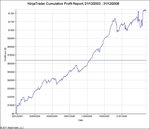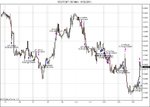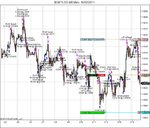Adamus
Experienced member
- Messages
- 1,898
- Likes
- 97
Re: Gap Filler system - starting from scratch again
After several programming mistakes which cost me several days of worktime and which made the results I collected completely confusing since they were all out of whack with the first set I had (above), I decided to start from scratch and build up the set of backtest results for the system as it develops.
Fortunately the first results I posted in msg 774 are correct, but I'm going to go back to the basic idea and post the results right from the bare bones system and onward.
For some reason NinjaTrader now can't run 2001-2008 without crashing. It can only cope with 2004-2008 and even then it crashes occasionally. Must be a memory thing. It provides more incentive to get my systems running on a VPS so I can use my trading machine as a dev box.
After several programming mistakes which cost me several days of worktime and which made the results I collected completely confusing since they were all out of whack with the first set I had (above), I decided to start from scratch and build up the set of backtest results for the system as it develops.
Fortunately the first results I posted in msg 774 are correct, but I'm going to go back to the basic idea and post the results right from the bare bones system and onward.
For some reason NinjaTrader now can't run 2001-2008 without crashing. It can only cope with 2004-2008 and even then it crashes occasionally. Must be a memory thing. It provides more incentive to get my systems running on a VPS so I can use my trading machine as a dev box.
I have to decide which switches and filters to apply. There are several to choose from as I have already outlined.
(1a) how much of the gap to aim for when placing target order - I haven't varied this and I don't think it's that important, but I chose 90% on the whim that I don't want to see that the price reached the target but the order was never filled.
(1b) enter on open in direction to close gap, exit all trades at end of day. This can be the baseline to compare everything against.
(1c) exit on closing gap, or at end of day.
(2) whether to base the stop size on Friday's range or on the average range e.g. 21 bar daily ATR - the results were no different. I decided to keep it simple and ditch the ATR, just using Friday's range.
(3) what % of (2) should be used for the stop size. I optimised this earlier, using a % of the previous days range, but I'm testing this time with one value for the whole portfolio. I can optimise later. This is the most important parameter.
(4) filter out the small gaps. I won't take gaps that were less than 5 points in size.
(5) filter out the huge gaps. I optimised this earlier - 40%, 50%, 60% etc of Friday's range.
(6) Friday's range can be divided into 5 zones with different probabilities that the gap will fill. If Friday's candle is 3 zones, (candlestick = 1 zone, wicks = 1 zone above & 1 zone below candlestick) the 4th zone is above the high and the 5th below the low. I don't know if the technical relevance of this in the S&P market is equally valid in forex though. I doubt it somehow.
(7) use an MA to filter out trades against the trend, maybe just a strong trend - in which case I need a trend strength indicator too
(8) another idea from this S&P gap trader is to place the entry trade as a stop away from the Open, to benefit from any market move away from the gap initially. This requires optimisation, or perhaps just placing it half way from the Open to the stop loss.
Last edited:




